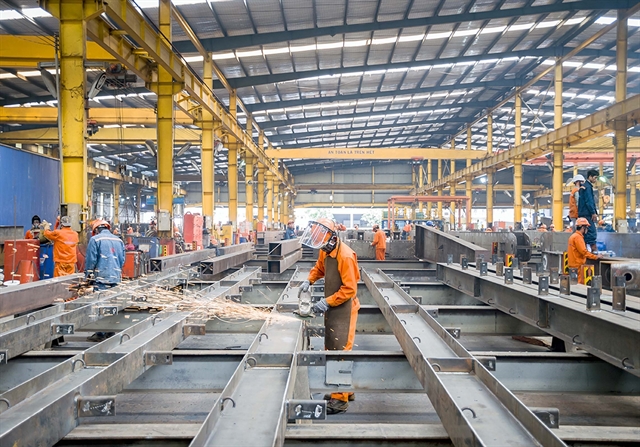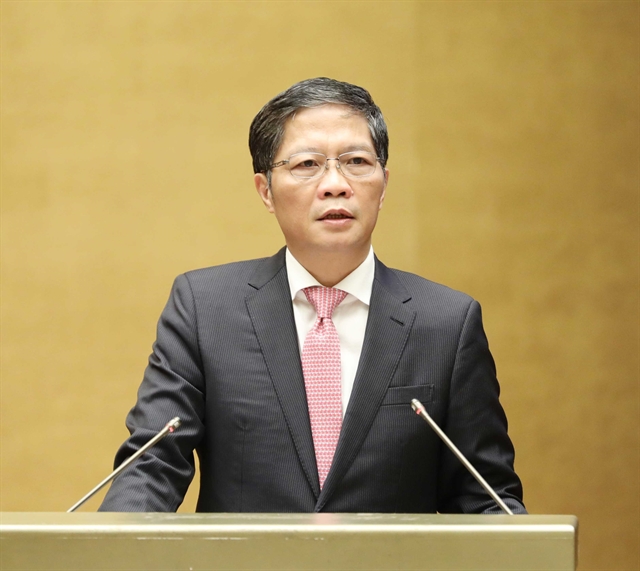 Opinion
Opinion

 |
| Workers work in a local construction engineering company in Bình Chánh District, Hồ Chí Minh City. Việt Nam is tasked to rapidly shift from outsourcing and assembly to producing, processing, designing and manufacturing. — VNA/VNS Photo Thanh Vũ |
In an interview with Vietnam News Agency on the sidelines of a national conference discussing the resolutions adopted at the sixth plenum of the 13th Party Central Committee, Politburo member and head of the Party Central Committee's Economic Commission Trần Tuấn Anh talks about the Party’s policies and directions to accelerate the country’s industrialisation and modernisation.
On November 17, 2022, the Central Committee of the Communist Party of Việt Nam issued the Resolution No. 29-NQ/TW on the acceleration of the national industrialisation and modernisation to 2030 with a vision to 2045. This is the first thematic resolution of the Party on this task. What is the meaning and importance of the resolution?
The promulgation of the resolution is essential and of great significance.
Firstly, industrialisation and modernisation is one of the central and cross-cutting tasks of the whole political system. They are also the means and motivation to achieve the goal of rapid and sustainable development of the country.
It can be seen that most countries in the world that strive to become a developed, high-income country, would carry out the process of industrialisation and modernisation.
Secondly, industrialisation and modernisation have been raised in many terms of the Party Congress. There have been about 20 resolutions promulgating a number of important guidelines related to industrialisation and modernisation. Resolution 29-NQ/TW is the first thematic resolution on this issue. The current regional and international context with rapid, unpredictable and complex developments along with the impacts of the Fourth Industrial Revolution also require us to have a new resolution that is more comprehensive to accelerate the industrialisation and modernisation.
There is room to improve and limitations that need to be addressed. They include slowed economic growth, middle-income trap risks, weak internal strength of the economy, slowly improved labour productivity. In addition, the key service industry accounts for a modest proportion of the economy, the linkages between manufacturing sectors are weak and urbanisation is not on par with industrialisation and modernisation. There are also shortcomings in cultural, human, environmental issues.
The resolution will be a guiding principle to specify the policies of the Party in socio-economic development. It is also an important political foundation in orienting new thoughts, policies, tasks and solutions to create a driving force for industrialisation and modernisation of the country.
 |
| Politburo member and head of the Party Central Committee's Economic Commission Trần Tuấn Anh speaks at a national conference on the resolutions adopted at the sixth plenum of the 13th Party Central Committee on December 6. — VNA/VNS Photo |
How are the Party’s points of view about the acceleration of industrialisation and modernisation reflected in the resolution?
There are five main points that reflect clear points of view and directions to accelerate national industrialisation and modernisation.
Firstly, industrialisation and modernisation is viewed as a foundational and comprehensive transformation of the economy and social life based mainly on the development of industry and services on the basis of science, technology, innovation and creativity.
Here, the role and significance of industrialisation and modernisation in the country’s socio-economic development are also reflected. It is viewed as the “central task of the nation’s socio-economic development strategy; its building of an independent, self-reliant and proactive economy that actively integrates into the world, develops rapidly and sustainably; and its goal to become a developed, high-income country”.
The second notable point is the Party’s consistent view of the acceleration of industrialisation and modernisation as the task of the whole people and the whole political system. And this task also takes into account the need to ensure harmony between economic development and social progress and justice, and environmental protection. Industrialisation and modernisation must also go with urbanisation, new styled rural development, growth model reform, and economic and labour restructuring.
The third notable content is the task to exploit and bring into full play all the potentials and advantages of the country, each region and locality as well as the advantages of the economy during and post-golden population. It also mentioned the task to rapidly shift from outsourcing and assembly to producing, processing, designing and manufacturing in Việt Nam while focusing on developing some specific services that are more knowledge and technology-intensive.
It also views digital transformation as a breakthrough method to shorten the process of industrialisation and modernisation. In addition, industrialisation and modernisation in agriculture and rural areas is one of the top priority tasks.
 |
| Ford Việt Nam factory in the northern Hải Dương Province. FDI enterprises are considered the “driving force” for industrialisation and modernisation in Việt Nam. —VNA/VNS Photo Trần Việt |
The fourth point of view emphasised that it is important to identify areas of focus, and key fields and industries for priority in the roadmap.
It also supplements and solidifies the Party's theoretical thinking on the subjects and resources for implementing industrialisation and modernisation. Accordingly, the domestic resources are considered the basic, strategic, long-term and driving factor. External resources are an important and breakthrough element, and domestic enterprises (including State-owned and private enterprises) are the key while FDI enterprises are the driving force for industrialisation and modernisation.
Lastly, it highlights the task to ensure macro-economic stability; actively integrate into the international economy; to nourish development aspirations, national entrepreneurship and innovation; to promote both traditional and modern cultural values, the bravery and intelligence of Vietnamese people as well as the pioneering role of Vietnamese intellectuals and entrepreneurs. —VNS




